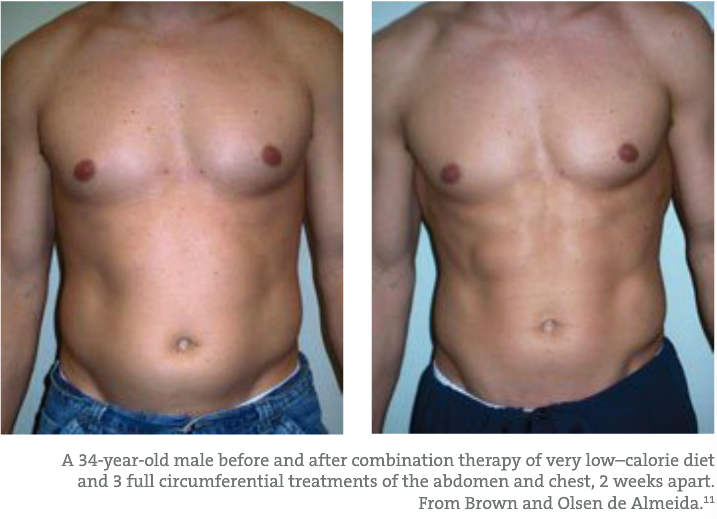Less-Invasive Body Contouring: Naturopathic Aesthetic Medicine for the Male Physique
J.D. McCoy, NMD
Aesthetic medicine is no longer “for women only.” Male and female patients want to look and feel good. Naturopathic aesthetic medicine uses non-invasive or minimally invasive treatments to turn back the clock, naturally, and restore the vitality of the skin and body. Modern –day administration of historically commonplace naturopathic treatments improve the youthfulness of the face and body through the following modalities: energy (coherent light/laser, intense pulsating light, advanced-florescent technology, near infrared light, radio-frequency, focused ultrasound), the body’s own healing power or substance (collagen, platelet-rich plasma, fat), and naturally occurring cosmeceuticals, hormones, nutrients, or biologics. Less-invasive aesthetic treatments reduce the patient need for surgery, focus on prevention, minimize downtime, discomfort, and risk, and invite the opportunity to address lifestyle modification (docere) issues.
According to the American Society for Aesthetic Plastic Surgery (ASAPS), from 1997 to 2010, cosmetic surgeries for men have decreased 18%, while non-surgical cosmetic procedures have increased 290%. The most popular cosmetic surgery for men is liposuction for contouring and fat reduction. Clinical body contouring options for men are available using non-surgical methods.
The ideal male patient is active, close to his ideal weight or is losing weight, and has a focused trouble spot. Most men tend to have increased adiposity in the lower abdomen and lateral flank1, which are the most common areas of treatment. Many patients may benefit from weight loss as a part of their body contouring strategy. Long-term success in maintaining results occurs when behavior modification is a part of the treatment2. However, many men who have a “healthy” body mass index (bmi < 25) or body fat percentage ranging from 10 to 24% (estimated ideal range, but not correlated to BMI)3 might have difficult fat that seems unresponsive to normal dietary intervention and exercise. These patients respond well to non-invasive treatments targeting subcutaneous fat and dermal tightening.
Various treatments can be used to target difficult fat and loose skin. Focused ultrasound has shown promise for non-invasive fat reduction of small areas4,5. Focused, non-thermal ultrasound, targets fat using acoustic energy, while surrounding tissue (vascular, nerve, muscular) is left intact. Body contouring with ultrasound is approved for use in Canada and Europe, and has limited availability in the United States (IRB sites, for example). Low-Level Laser Therapy (LLLT) exhibits measurable volume reduction in the waist and thighs6. An LLLT device can treat a large area or focus on common resistant areas. A 685 nm diode light causes adipose cellular content to empty into the interstitial space, without any discomfort or downtime7.
Volumetric heating of the subcutaneous fat with Radio Frequency (RF) energy causes contraction of the tissue and an overall circumferential decrease8,9. RF treatment is used globally on the face and body, but in men it is primarily used to treat the lower abdomen, lateral flank, and lower back. A common RF device today applies an RF energy of 40.68 MHz to provide deep dermal heating and tightening (neocollagenesis), improved circulation and lymphatic drainage, and thermally induced fat cell damage10.
Men can also benefit from mineral-rich mud wraps that use nutrient repletion, improved circulation, and lymphatic drainage to improve detoxification and induce circumferential reduction. Inch loss does not appear to be correlated to dehydration, since measured loss is apparent months beyond the time of wrapping11. Weight-management protocols such as a structured very low calorie diet, intermittent fasting, elimination-rotation diet, and reduction of excess refined carbohydrates contribute to results. Behavior modification protocols such as sleep regulation and cardiovascular and weight-resistant exercise can also contribute to results.
Overall success and maximized contouring of the male physique comes from combination therapy. A variety of treatments works synergistically to improve outcomes, and different types of complimentary electromagnetic energy-light and RF treatments activate designated target areas through the subcutaneous fat and dermis.

The demand for safe, effective, and non-invasive body contouring treatments for men is growing. Advancing technology, proper patient selection, and combining procedures with behavior modification maximize outcomes. Naturopathic aesthetic medicine can contour the body and deliver tangible, satisfying results.
 J.D. McCoy, NMD graduated from the Canadian College of Naturopathic Medicine in 2001. After completing an internship in internal medicine in Hawaii, he began specialized training, certification, and work in cosmetic and light-based therapies. His current practice is highly specialized in aesthetic medicine, which includes: laser treatments, IPL photo-rejuvenation, chemical peels, cosmetic injectables, mesotherapy, contour thread lift, and facial resurfacing. Dr. McCoy is a Luminary Physician with Alma Lasers and a Certified Physician Speaker and Advanced Injection Trainer. He is also one of only a handful of physicians in Canada and the United States using the Thermigen for radio frequency skin tightening and fat contouring.
J.D. McCoy, NMD graduated from the Canadian College of Naturopathic Medicine in 2001. After completing an internship in internal medicine in Hawaii, he began specialized training, certification, and work in cosmetic and light-based therapies. His current practice is highly specialized in aesthetic medicine, which includes: laser treatments, IPL photo-rejuvenation, chemical peels, cosmetic injectables, mesotherapy, contour thread lift, and facial resurfacing. Dr. McCoy is a Luminary Physician with Alma Lasers and a Certified Physician Speaker and Advanced Injection Trainer. He is also one of only a handful of physicians in Canada and the United States using the Thermigen for radio frequency skin tightening and fat contouring.
References
- Proc Nutr Soc. 2000 Aug;59(3):331-6.
- Pathophysiology of obesity. Lean ME.
- Drugs. 1990 ;39 Suppl 3:20-32.
- Management strategies for weight control. Eating, exercise and behaviour. HYPERLINK “http://www.ncbi.nlm.nih.gov/pubmed?term=%22Caterson%20ID%22%5BAuthor%5D”Caterson ID.
- International Journal of Obesity. 2002 June;26(6):789–796, HYPERLINK “http://www.nature.com/ijo/journal/v26/n6/full/0802006a.html”The effect of sex, age and race on estimating percentage body fat from body mass index: The Heritage Family Study. Jackson et al.
- Plastic and Reconstructive Surgery. July 2009;124(1):92-101. Characterization of Non-thermal Focused Ultrasound for Non-invasive Selective fat Cell Disruption (lysis): Technical and Pre-clinical Assessment. Brown et al.
- Plastic Surgical Nursing. April/June 2010;30(2):77-82. Nonsurgical body Contouring with Focused Ultrasound. Hotta T.
- Lasers Surg Med. Dec 2009;41(10):799-809. Low-level laser therapy as a non-invasive approach for body contouring: a randomized, controlled study. Jackson et al.
- Obes Surg. June 2011;21(6):722-9. Efficacy of low-level laser therapy for body contouring and spot fat reduction. Caruso-Davis et al.
- J Drugs Dermatol. September 2006;5(8):714-722. Effect of controlled volumetric tissue heating with radiofrequency on cellulite and the subcutaneous tissue of the buttocks and thighs.
- Lasers Surg Med. December 2009;41(10):745-50. Controlled volumetric heating of subcutaneous adipose tissue using a novel radiofrequency technology. Franco et al.
- Almalasers.com. Accessed 2011. Novel radiofrequency (RF) device for cellulite and body reshaping therapy. Brown A and de Almeida O.
Case study of Slimmer Silhouette wraps in two patients and pre and post measurement review in 50 patients. September 2010. McCoy JD. Patient treated at Contour Medical, Gilbert, AZ. Keiffer J and McCoy JD.










